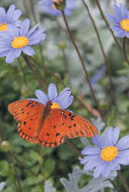
![]() chapter FOUR
chapter FOUR ![]()
Landscapes & Special Gardens
Mild winters and ample sunshine are trademarks of the Coachella Valley, allowing a wide range of plants to be grown successfully. In this chapter, you’ll find detailed information on many types of gardens and plants, including roses, citrus, fruits, vegetables and lawns. You’ll learn how to handle specific kinds of garden situations, such as landscaping around pools and patios, creating a wildlife habitat, and how to grow plants in containers. In addition, you’ll find a detailed guide to help you give your garden an extreme makeover—creating a lush, attractive, water-efficient landscape.
It is difficult for the majority of first-time desert residents to develop a plan of action for their new landscape. When you consider that they are working with unfamiliar plants in growing conditions that seem downright hostile, this makes perfect sense! But that is the reason for this book. With careful understanding of each plant’s character and mature size, and with some thoughtful planning, a pleasing landscape will emerge. No matter what size your yard, following some basic guidelines can show you how to plan and install a water-conserving landscape you’ll be sure to enjoy.
First, draw a base plan of your lot that shows the location of home, walks, patios and driveway slabs—all areas of hardscape that exist on your lot. (These hardscape areas should be in place before beginning any landscaping.) In addition to walks and patios, there may be a need to construct walls for privacy or as a windbreak. Note these as well.
On your plan, note items such as utilities and access for trash receptacles. Include any landscape plants or existing features that you want to keep. Making a scale drawing on graph paper is ideal, but even a sketch of available space provides a snapshot of what exists, and a starting point.
Make several copies of this base plan. Now is the time to try out your ideas. Draw in all the different plants and gardens you might like, such as a vegetable garden, herb garden, shade trees, fruit trees, vines or even a fountain.
Consider functional spaces within your yard as well, such as an area for a barbeque grill, seating for entertaining, or space for a pool or spa.
If you are interested in growing vegetables or flowers, consider constructing narrow raised beds. Make them wide enough to provide a seating ledge—useful when planting, weeding and harvesting.
Consider adding a change of elevation for interest, such as natural-shaped earth mounds, a raised planter against the back wall, or a dry creek bed to follow a slope. All will help set the stage for wildflowers, ground covers and accent plants.
Visit retail nurseries and botanical gardens for ideas on the plants you want to include. Choose plants for their seasonal color, beauty, hardiness to cold, ultimate height and spread and water requirements. Research trees carefully, and know how much space you have available for their mature height and spread. Maintenance requirements, including the amount of litter they typically create, are other important aspects.
Before you even think about digging planting holes, mark the locations of major plants with stakes. A garden hose or heavy string can be used to outline proposed planting beds. Spend some time in the yard to be sure that the proposed layout works for you. Go inside and look out your windows to imagine how the plants will look from that important viewpoint.
Adequate soil drainage is necessary to avoid areas of standing water in the landscape. Make the soil level next to hardscape areas 2 inches below grade.
Plan an irrigation system and layout after you determine plant locations. Drip irrigation with automatic valves will water plants where and when they need it, reducing your water bill.
Plant properly. See step-by-step guidelines in chapter one. Allow correct amount of space between plants and hardscapes. Take into account their full mature growth even if plantings appear sparse at first. You can always add annuals and perennials as temporary filler for a year or two until trees and shrubs begin to assert themselves.
_fmt.jpeg) This inviting home entry is composed of an attractive combination of water-efficient plants.
This inviting home entry is composed of an attractive combination of water-efficient plants.Making a Small Landscape
Less can be more. Even if you live on a small lot with limited garden space, it can still be as beautiful and enjoyable as a garden in a large lot, with less maintenance chores. Many of the same trees, shrubs, vines, ground covers, annuals and perennials that grow successfully in large-scale gardens are compatible in smaller planting locations. Just be sure you take into account mature plant sizes as you do your planning.
Due to the smaller area, gardening solutions must be more creative. Trees or shrubs that you can espalier—train against a wall or fence—provide one option. Especially consider the use of vines for getting the most out of garden space. They can be trained up fences and walls to surround your home with color and cooling greenery, taking up little ground area.
_fmt.jpeg)
Low-water and low care: Bright green myoporum ground cover combines with magenta bougainvillea in the background.
Giving Your Old Landscape a Makeover
Even if it has only been five years since your landscape was installed, many new, beautiful, water-efficient shrubs, trees, accent plants, ground covers and bright flowering perennials are available in a wide range of colors and growth habits. Ornamental grasses, as well, are becoming more popular. They, too, are available in a range of sizes and colors, their leaves and seedheads creating interesting flowing patterns. Vertical accent plants, many of which are succulents, add their own brand of new visual impact. See Cacti and Succulents, for an array of choices.
If you have a front lawn, consider replacing it with interesting, natural-shaped contours and mounds planted with water-efficient flowering shrubs, perennials and ground covers. Add some boulders, a few accent plants, and some low-water flowering perennials. Now your once-common, monochromatic green grass yard is a visual feast for the eye. And it will use about half the water as the lawn.
You can also choose to retain some lawn, but reduce its size. This will cut back on water outlay, as well as time spent fertilizing, mowing and otherwise maintaining it.
Bordering lawn with a clean edge can enhance the overall appearance of your landscape and give it a finished appearance. The contrast of rich green grass against light-colored mulch such as decomposed granite or soil can be highly attractive.
Follow the steps outlined in Planning Your Landscape. Doing a makeover of an established landscape requires a thorough review of the site. This includes noting existing problems, then developing a theme or plan—including a budget—before beginning work.
Include in your calculations how much longer you intend to live in your home. If you plan on staying three years or more, be more expansive with your makeover. If you will be selling your home in less than three years, it’s probably more economical to tidy up the landscape, get rid of clutter, eliminate glaring problems and maintain it to its potential.
To develop a complete review for a potential makeover, it may be worth the services of an experienced landscape designer or landscape architect. A professional can define the scope of work, develop a time frame and prepare a budget.
As part of the makeover, evaluate the worthiness of all plants that are on site. Trees especially should be carefully reviewed. Are they healthy? Is their height and spread in proportion to the available space? Are limbs rubbing against structures, or are roots uplifting walks or walls? Are they well-adapted to the desert environment? Consider other plants as well. Have shrubs and ground covers become woody? Has continual pruning all but eliminated flowering? Are there any plants on site that you simply do not like?
_fmt.jpeg)
Boulders combine with brightly colored bougainvillea (center), Murphy's agave (left), and yellow-flowering aloe vera.
Some Makeover Solutions
o It is not always wrong to remove a tree, especially if it is causing problems. Trees in poor condition, problem trees, trees planted in the wrong place, or trees at the end of their life span should be removed.
o Remove worn out evergreen shrubs and replant with desert-adapted flowering shrubs and perennials.
o Upgrade flower beds with small shrubs, also called subshrubs, which generally produce more flowers over a longer period. Perennials can also take the place of annual flowers. They produce colorful flowers and are less costly than planting and replanting large beds of annuals several times a year.
o Add in accent plants and low-profile ground covers to create a new, fresh look that also reduces water use.
o Replace or reduce the size of large lawns with graceful, flowing plantings of perennials, ornamental grasses and accent plants.
o A well-constructed lawn edging contains the lawn and gives definition to lawn and planting beds. Use pressure-treated wood or other landscaping timbers for edging, or durable edges such as metal, brick or concrete. Limiting the lawn perimeter and avoiding small, narrow or oddly shaped sections will make it easier to irrigate and maintain.
o Artificial turf has improved in appearance and longevity in recent years. It can be an option to provide a splash of green color to a back yard.
o Give your irrigation system a makeover. Replace old irrigation watering heads with more water-conserving equipment. Most PVC pipe irrigations systems can easily be converted to water-saving drip systems. Irrigation, including how to upgrade and maintain an existing system is discussed in chapter 2.
Landscaping Near Pools and Patios
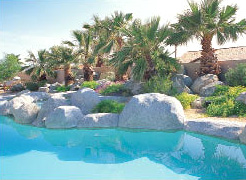
Palms are ideal plants near pools. They create a tropical mood and are generally litter-free.
The areas around pools and patios are some of the most difficult places to landscape attractively and for low maintenance. From a plant’s point of view, such locations can be less than ideal for growth. Pools add reflected light and hot concrete decking to the already high heat. Chlorine in pool water may splash on plants, injuring or killing them.
Patios are difficult because a portion of the earth for plant roots is covered by a large, non-porous surface. But there are still ample plants available for these sites, especially if you follow a few guidelines.
To avoid constant problems with sweeping, raking and cleaning, select and plant low-litter plants. All plants will produce some amount of litter, but some plants are messier than others. The descriptions in Plants for Desert Success often lists whether a plant is high or low on the litter scale.
Swimming Pools
The landscape around a pool becomes more appealing when you use plants that are dramatic in form, texture or color. Avoid using plants with thorns, as well as those that produce high litter.
Palms are among the most favored trees for around pools. Consider trying some newer selections, such as Brahea armata, Mexican blue palm, or Brahea edulis, Guadalupe Island palm. Both are slow growing and typically remain under 20 feet high.
Tried and true is Washingtonia filifera, California fan palm. It grows slowly to 35 to 40 feet, with a massive trunk up to 3-1/2 feet in diameter. Washingtonia robusta, Mexican fan palm, has a slender, 18-inch trunk that can reach 50 to 75 feet high. This height makes it a skyline tree and should only be used in large-scale gardens.
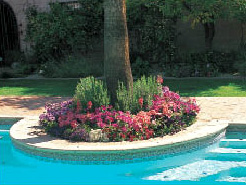
A poolside planter features colorful annuals with upright rosemary as a living centerpiece.
For smaller gardens and for close-up viewing, consider Chamaerops humilis, Mediterranean fan palm. It is typically multi-trunked growing 8 to 12 feet high. Growth is slow. Welcome the pups, offshoot plants, that fill in around the base. Leave them on the palm to encourage growth to develop more vertically. This palm is also excellent when grown in containers.
Although palms are popular, there are a number of other evergreen trees and shrubs that are attractive around pools. Consider Acacia aneura or Acacia craspedocarpa, two low-litter species from Australia. Acacia willardiana, palo blanco, is native to Mexico. It will accept reflected sunlight and heat near pools and adds a graceful, weeping-willow-like feel, as does Callistemon viminalis, weeping bottle-brush. Olneya tesota, desert ironwood, Sophora secundiflora, Texas mountain laurel, and Pistacia lentiscus, evergreen pistachio, are additional trees to consider for poolside plantings.
In planting areas near a pool, it becomes both functional and visually appealing to use creeping ground covers. Select species that root along the branches, which helps stabilize the soil to keep it from blowing into the pool. Include some taller accent plants to partner with the ground cover to create more interest. Add a few boulders or statuary to complete the scene.
Especially attractive ground covers for poolside landscapes include Chrysactinia mexicana, damianita, Convolvulus cneorum, silver bush morning glory, Oenothera stubbeii, Saltillo primrose, Ruellia brittoniana ‘Katie,’ dwarf ruellia, and the creeping evergreen herbs, Rosmarinus officinalis ‘Prostratus’, prostrate rosemary, and Teucrium chamaedrys ‘Prostratum’, prostrate germander.
Many lush, flowing ornamental grasses are at home around pools, especially as a backdrop. Consider Muhlenbergia species, which are attractive almost year-round, and are low-litter plants.
High-litter plants to avoid include oleander, bougainvillea, pyracantha, eucalyptus, ash, pines, privet, mesquite and palo verde. If you want to include these plants for shade, screening, or other functions, try to place them 25 to 35 feet away, ideally on the downwind side of the pool.
For a final touch, install night lighting on palms and bold accent plants to enhance the pool landscape. The play of light reflections on plants and water add to the beauty of the scene.
Patios
A patio can be a wonderful place to sit and enjoy your yard. There is nothing comparable to relaxing on your own patio with a morning beverage and the paper, with birds singing in the colorful shrubs around you. Come back to the patio in the evening and enjoy the company of friends as you grill some steaks for dinner. The patio should be designed so that it is another room of your home.
Creating intimacy in a large or small patio merits close attention to detail when selecting and placing plants. A patio area provides an opportunity to become your private mini-oasis. In general, you want to select plants that have colors and textures that are appealing when viewed up close.
Flowering vines, espaliered plants and fragrant color plants in containers add special interest at the edges of the patio area. If the rest of your garden is low maintenance, these are prime locations to showcase plants that you enjoy the most: a small herb garden, vegetables in containers, or special tropical or subtropical plants.
Beds at the edges of the patio can be filled with flowering perennials or annuals to add their bright, gem-like effects. Also consider bonsai plants for their up-close appeal. While you want planting beds near the patio, where you can most enjoy them, you also want sufficient space for walkways and paths to reach other parts of the yard. Also factor in easy access to other features, such as table and chairs, grill, pool or spa.
Water Features—Pools and Fountains
The cooling sight and relaxing sound of water simply can not be surpassed as a finishing touch to a landscape. This is especially true in a desert climate, where water is precious. And if you enjoy statuary, you can include some in even the smallest garden as part of a water feature.
Water features can be formal, such as a Spanish-style fountain, or informal, like a natural-appearing waterfall and pool. Select the style that blends the best with the rest of your landscape.
The style of water feature (formal or informal) dictates the type of plants placed around it. A formal feature should be landscaped with plants that remain tidy with little care, such as junipers or myoporum.
For an informal water feature, surround with free-form plants. Vertical forms can provide accents among rock groupings near your water feature. Larger plants include Muhlenbergia lindheimeri, Lindheimer muhley; Hesperaloe parviflora, red hesperaloe; Dietes vegeta, butterfly iris; and Dasylirion longissimum, toothless sotol. Smaller plants include Nassella tenuissima, Mexican thread grass; Zephyranthes species, rain lilies; and Bulbine frutescens, bulbine.
For fillers in the background, try the fascinating gray foliage of Buddleia marrubifolia, woolly butterfly bush, combined with the silvery gray foliage of Encelia farinosa, brittlebush. Offset these with the brilliant green foliage and bright flowers of Salvia greggii, autumn sage. All are sun-loving and water-efficient, and blend well with other desert plants.
Not to be forgotten are cacti and other succulents. They can be tucked in many places in the landscape. Smaller species can be used among rocks and boulders to provide miniature desert scenes for close-up viewing. Larger ones can be placed farther away for charming accents.
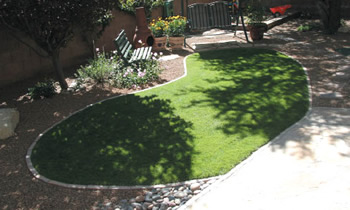
Bordering a lawn with a clean edge can enhance your landscape, giving it a finished appearance. This lawn is small and requires much less water and care than a traditional wall-to-wall lawn, yet it still provides cool, green relief.
Reducing an existing lawn area or making new lawns smaller than typical in the past helps curtail water use. Yet even a small lawn provides an important surface for play and visual relief from the earth tones of the desert. If you do have a lawn or are planning one for a new landscape, ask your nursery or sod grower about the current crop of water-conserving lawngrasses and how to water and maintain them.
In the Coachella Valley, the most easily grown grasses are the permanent, warm-season Bermudagrasses. They are seeded—common Bermuda only, or sodded— hybrids, such as the ‘Tif’ series. Hybrid Bermudagrass provides a close-knit carpet that wears well. Its seed is sterile, so it must be planted from sod or stolons. Some hybrid varieties are slow growing so less frequent mowing is required.
Hybrids are fast becoming the favorites, due to their finer texture and richer color. Indeed, some communities do not permit common Bermudagrass plantings due to its multiple problems. Common Bermudagrass readily goes to flower, producing highly allergenic pollen. It also reseeds, and is an aggressive spreader, becoming a weedy, invasive nuisance in other plantings. Color and texture are not as attractive. Hybrid Bermudagrass is highly preferable.
Many types of grasses have been tested, but, to date, few show much promise. Buffalograss from Texas and northern Mexico may have the potential to be a high-quality, warm-season turf with better winter color than Bermudagrass, eliminating the need for overseeding in winter. However, it is not yet commonly available.
Overseeding a Winter-Dormant Lawn
Bermudagrass is a warm-season grass that becomes dormant with cold temperatures. It turns a straw color, but most folks prefer a green lawn. Our choices for green lawn in winter then become cool-season grasses. Sowing cool-season grass seed over a dormant Bermudagrass lawn, called overseeding, allows the gardener to have a green, thriving lawn all year-round.
One of the main gardening chores in the low desert is the annual exercise of overseeding Bermuda lawns with ryegrass. Thousands of acres of lawns in parks, on golf courses and around homes go through this ritual each fall—when soil temperatures are 72°F to 78°F. This usually occurs October 1 to October 15. During this time annuals, perennials and bulbs are also planted for winter and spring color.
Annual ryegrass and perennial ryegrass are the most common cool-season grasses used for overseeding. Annual rye grows rapidly, however, its ample growth demands more frequent mowing. Annual ryegrass leaves tend to be weaker and a lighter green color. It is less expensive than perennial rye. Perennial rye grass has greater vigor and develops more sturdy, spreading growth. Germination period for both types is generally 3 to 10 days, depending on moisture coverage.
Other grasses such as rough-stalked bluegrass and bentgrass are used on golf greens for putting surfaces. These fine-bladed grasses require much more maintenance than the rye grasses. Ask your cooperative extension or local nursery about the finer points of selecting a grass that will work best for your lawn situation.
Container plants on your desert patio, at the entrance to your home or around the pool can play a personal or even sentimental role. In these areas you can showcase your favorite plants, and enjoy them at close range. These include plants that offer interesting structure such as bonsai plants, as well as colorful annuals, bulbs and fragrant flowering perennials or even shrubs.
The portable container garden can move with you from one home to another, and, if placed on casters, containers can be moved according to the weather or the season. Move them out of the range of extremes in cold weather in winter, or to a shaded location as the heat and sun intensity increases in the summer.
Containers are a wonderful way to enjoy a diversity of plants even if you live in a small lot. Large containers can function as a screen or as a way to divide a garden or outdoor area. Containers are also a good way to raise plants to a height that is easier to work with, especially helpful for folks that have trouble bending and crouching. When it comes to vegetable gardening in containers, the dreaded chore of weeding is dramatically reduced. Plus many vegetable plants have an attractive, ornamental quality that you can be showcased in a container.
Where you place your containers is entirely dependent on the need of sun or shade for each plant. If containers are mobile, you can move them as needed to protect plants from frost, wind, reflected heat and intense sunlight.
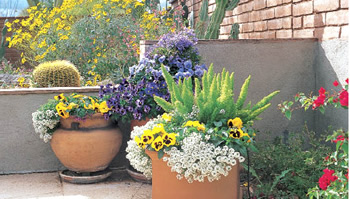
The portable container garden can move with you from one home to another. These containers are filled with colorful annuals and perennials, including white sweet alyssum, pansies and foxtail fern, Asparagus 'Myers'.
Container Choices
Select containers that are best adapted to deal with problems associated with our desert heat.
Containers can be porous, which allows evaporation of moisture through the sides. Porous materials include unglazed clay, terra cotta or wood. Care must be taken that these types do not lose moisture too rapidly during warm periods of the year. However, if you water plants regularly, porous containers are more forgiving than non-porous ones.
Non-porous containers include those made of porcelain, glazed ceramic and plastic. They allow less evaporation through the sides. It is easier to overwater these types of containers because evaporation of water is reduced. All containers must have a drainage hole or you run the risk of killing the plant with constantly saturated soil, which greatly reduces oxygen.
Soil for Containers
Most container plants are generally forgiving when it comes to soils. A quality, general-purpose soil mix is one-third ground bark, peat moss, or composted planter mix, one-third coarse sand, and one-third garden soil. Blend all three into a loose, friable mixture and moisten before you plant. Many brands of packaged mixes are available at nurseries and garden centers.
Succulents, particularly cacti, need good drainage and generally less acidic soil. Use a mixture of one-third garden soil, one-third porous matter such as perlite or vermiculite, and one-third sand.
Despite what many of us were taught years ago, new research shows that it is detrimental to plants to put anything other than soil into pots. Do not put stones, gravel, pots shards or anything in the bottom—it actually harms drainage. If you feel you must cover the drainage hole, use a piece of old window screen or nylon stocking.
Leave space at the top of the container—one to three inches—depending on the size of the container and plant type. This allows room for each watering. With each irrigation, water should flow through the soil mix on new plants as well as saturating the root ball of established plants.
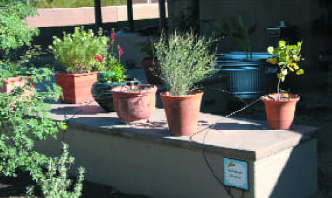
This demonstration garden shows a simple, yet effective method of using drip irrigation to water container plants.
If water is flowing out of the container bottom too rapidly, there may be soil shrinkage due to excessive root growth. Water is not penetrating the rootball, but merely moving around and down the sides of the container, doing the plant little good. When this occurs, it’s time to replant with fresh soil in a larger container.
Top-dressing the container soil is an option. Top-dressing is any inert material in a 1- to 2-inch layer over the soil in pots. Pea gravel, small lava rock or smooth stones are topdressing materials. It reduces evaporation, prevents crusting of the soil, reduces water splash and improves appearance.
Fertilizer must be furnished more frequently for plants in containers than for those in the ground. Measure and apply carefully according to label directions. Liquid types of organic fertilizers work best. Moisten soil prior to application and water it in. Don’t overdo fertilizer thinking “a little more” will help. Overfertilizing kills plants. For cacti and succulents, use fertilizer at half strength.
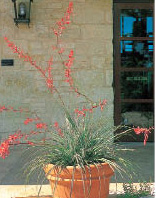
Red yucca, Hesperaloe parvifolia, makes a dramatic, container specimen.
Container Plants
Containers can be used to house a single plant, or become a miniature garden with a number of different plants. Ideally you should match colors and shapes of pots to the plants you place in the container.
For a pleasing blend of plants, the adage is “accent, filler, and spiller.” There should be an upright accent plant in the center, filler around it, and a spiller cascading over the edge. This can be done with any plants that share the same water requirements. Use succulents, perennials, annuals, bulbs or an enticing blend of vegetables and herbs.
Containers are the most effective way to enjoy certain plants that are otherwise not candidates for growing in the desert. For example, some plants require acid soils and do not adapt well to treated soils. These include camellias, gardenias and azaleas. They generally do better in porous pots that evaporate through the sides.
Containers are also ideal for some species of bulbs that are unable to survive hot soils, including Dutch tulips, daffodils, and hyacinths. Note that the Turkish tulips do fine in the desert garden.
Succulents, including cacti, are a special part of the desert landscape. The majority are highly adapted to container culture. Most have fascinating shapes, textures and colors, making them ideal to collect and showcase in containers.
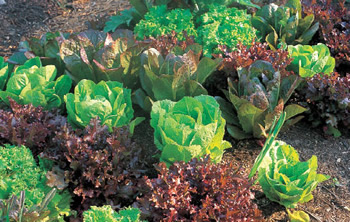
Winter vegetable gardens—cool-season crops—are usually more successful than summer gardens because plants avoid intense heat. This planting of assorted lettuce varieties is not only bountiful but highly attractive.
The Coachella Valley offers a wonderful climate for growing vegetables and fruits. Indeed, fruits and vegetables are grown commercially in the valley and shipped throughout the world. Growing conditions for vegetables are most favorable during fall, winter and into spring. Summer vegetables are more difficult to grow, but with the right heat-loving varieties and proper cultural practices, gardeners can be successful.
If you are a new gardener or new to the desert, it is best to begin with a fall garden. Gardening in fall is more forgiving without the extreme summer heat, and you’re more likely to enjoy harvests that will be tasty and abundant. Keep in mind that even winter-grown gardens need irrigation on a regular basis.
Ideally, plan on succession planting your garden vegetables. This means sowing new seeds or setting out young plants every three weeks or so, not all at once. This will stagger and extend harvest times and avoid having an overabundance of produce all at one time.
It is possible to grow many vegetables in a small plot, in containers, in borders or along a wall or fence. Select an exposure where vegetables will receive at least six hours of sun every day.
Prepare soil well in advance of planting. Remove rocks, weeds and debris, then grade to create a smooth, level, ready-to-plant bed. Moisten soil to about 2 feet deep. Add ample organic material such as compost or forest mulch and mix thoroughly. Or, consider a raised bed garden surrounded by a low wall. You can sit and work in the garden, making it easier to plant, irrigate, thin seedlings, remove weeds and harvest crops.
When sowing seeds directly into the garden, be aware that each seed has a preferred planting depth. You’ll find directions on seed packets. Don’t plant too deep.
After planting seeds, tamp the soil firmly. Water seeds to remove air spaces in the soil. Use a fine-mist sprinkler or hose attachment to avoid disturbing or washing out seeds. Continue to sprinkle soil lightly on a regular basis until seeds germinate and seedlings produce three or four leaves. Now begin watering with a soaker hose or irrigation system. Check the soil for moisture several times a week. Dig down at least 6 inches deep and feel if the soil is moist. Be consistent with watering. A dry period can slow down or interrupt the growth process, which will likely reduce the amount and quality of harvests.
Planting a Winter Garden
The time to begin planting a winter garden is mid- September. The soil is warm and cooler temperatures that are soon to come are ideal for growing green leafy vegetables and root crops such as beets, carrots, endive, leeks, lettuce, green onions, radishes, spinach, turnips, broccoli, bok choy, pak choy, Brussels sprouts, cabbage, chard, mustard and peas. This is also the time to grow cool-season garden herbs such as cilantro, chives, parsley, dill and fennel.
Planting a Summer Garden
Beginning in early February, you can plant many of the warm-season crops—onions, garlic, potatoes, tomatoes, sweet corn, squash, gourds, eggplant, sweet or bell peppers, chili peppers and melons. The prime summer herb is basil. Many summer vegetables are handsome plants, and can be mixed into flowerbeds.
Plant seeds or set out young tomato, pepper and eggplants after all danger of frost has passed. In the Coachella Valley the average dates for the last frost can range from late January to early March, but the official date is March 1. Seedlings and plants in 4-inch pots are usually available at local nurseries during this time, ready to plant. A word of caution: don’t set out a large number of plants. Just a few plants of most vegetables will produce enough harvests for the average home.
Because intense heat is coming all too soon, plant varieties that are early maturing and heat tolerant. Native varieties of crops, rather than hybrids, often do better. A number of seed companies are now providing desert-adapted varieties of common vegetables.
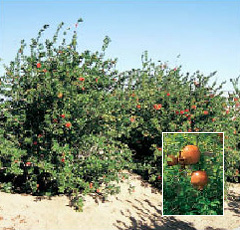
Pomegranate is a 'triple-treat' plant. It is attractive in the landscape, and produces striking, bright red flowers that are followed by its tasty fruit.
A wide variety of fruit- and nut-producing plants grow well in our desert, and can be done without an extensive orchard. Many landscape trees, shrubs or vines will also provide you with delicious harvests. Select from apricot, citrus, date, elderberry, fig, grape, olive, peach, pear, pecan, persimmon, pistachio, plum, pomegranate and exotic tropicals such as guava, pineapple guava, natal plum, loquat (Japanese medlar), and jaboticaba. (Avocado is tropical as well but may not survive our periodic freezes.) A number of native plants provide edible fruit, including prickly pear, cholla, squawberry, wolfberry, saguaro and velvet mesquite, the pods which can be ground into a sweet flour.
Deciduous Fruit Trees
Deciduous trees, those in which leaves drop from branches in winter, are often placed in the background of the landscape. Although it is an excellent energy-saving practice to locate deciduous trees along a south-facing wall for summer cooling of the home, only do so with figs and pomegranate from the list following.
Figs—Silvery gray bark and lush green leaves place figs at the top of the list for an oasis landscape. If your landscape space is limited, figs can be espaliered. There are ten commonly grown varieties of figs, and all do well in the Coachella Valley. Selection then becomes a matter of taste.
‘Mission’ is the most dependable, all-around fig, typically producing two crops per year. Fruit has black skin. Use fresh, dried or preserved. ‘Kadota’ has yellow skin and amber pulp. Fruit is good when dried. ‘Brown Turkey’ is best eaten fresh.
Peaches and Nectarines—Select from low-chill varieties of peaches such as ‘Blazing Gold’, ‘Gold Dust’, ‘Desert Gold’ and ‘Babcock.’ They ripen early and produce reasonable crops. Also consider ‘Party News Four Stars,’ which produces in mid-season. Dwarf ‘Bonanza Peach’ eventually reaches 6 feet high. Its mature size is suited to border areas, or even grow it in a large container. Old favorites such as ‘Elberta’, or ‘J. H. Hale’ are not adapted to our low desert climate.
Nectarine varieties with low-chilling requirements include early fruiting ‘Desert Dawn’, ‘Gold Mine’ and ‘Sunred’.
For all peaches and nectarines, prune to remove two out of every three branches formed the previous year to create new fruiting wood and improved harvests.
Pomegranates—A succulent fruit from ancient times, pomegranates have been grown in low-elevation deserts for many millennia. They tolerate alkaline soils well, and add year-round interest to the landscape. Spring brings large, vivid red flowers, followed by ruby red fruit against brilliant green foliage. Fall foliage is golden yellow, and in winter, the bare branches and trunks show off their smooth, silver-gray bark.
Full sun is important. Bare-root trees can be planted in December, January and February. Container-grown plants can be set out any time, with fall the best period.
Regular deep irrigation is required for crop production. Selectively prune one-third of the previous year’s growth each winter or trees become too twiggy.
‘Wonderful’ is an improved selection generally grown as a large shrub to 10 feet high and as wide.
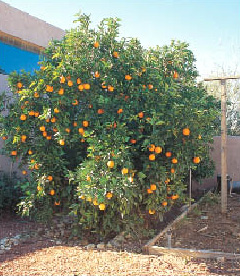
'Valencia' orange is one of the easiest citrus to grow. It is primarily used as a juice orange.
Citrus trees are abundant in their offerings to desert gardeners, with lush evergreen foliage, fragrant flowers and decorative, tasty fruit. High heat required by most citrus is easily met in the Coachella Valley. Full flavor and juiciness develop better here than almost anywhere.
Planting New Trees
Citrus plants need deep, well-drained soil. In frost-free areas they can be planted any time. In colder parts of the valley, wait to plant in spring after danger of frost has passed (March 15).
When planting more than one tree in an average-sized garden, space grapefruit 20 feet apart; most other citrus 15 feet apart. Plant in the warmest location available—in full sun or with some afternoon shade.
Irrigating Newly Planted Citrus—Build a basin around newly planted plants at least 4 feet in diameter with sides about 6 inches high. For March-planted trees, fill basin and soak soil to 2 feet deep at least twice a week from March to May. Soak to 3 feet deep about twice a week June through September. Extend watering frequency to every 10 to 12 days during winter months. By March the tree can be considered established and can be irrigated as a mature tree.
Irrigating Mature Citrus—After trees are established, maintain a dry area about 12 inches in diameter area around the base of the trunk. Slightly raise the soil level so that the basin tapers down and away from the trunk, preventing water from coming in regular contact with the trunk. This reduces the chance of gummosis, a disease that can kill plants. Continue to extend the edges of the basin as the tree grows. As a guide, make the basin slightly wider than the spread of branches.
Irrigation depth for citrus is ideally 3 to 4 feet, allowing the soil to become mostly dry prior to watering again. In sandy soils, water trees every 10 to 14 days from March through May. Water once a week from June through September. Water every two to three weeks from October through February. Water less often in heavier clay soils.
If in doubt about how much and when to water, check the soil for moisture. It is simple to check irrigation depth with a soil probe. This is a long, metal rod (purchased or handmade) that can be pushed into the soil. It penetrates as deeply as the moisture, stopping when it reaches dry soil.
Mulch materials—bark, planter mix, even rocks and gravel, to name a few, should be applied over the basin area to keep roots cool, reduce water loss through evaporation and to suppress weed growth. A 3-inch layer of mulch will keep roots 8°F to 10°F cooler. This also helps reduce digging or cultivating, which will disturb surface roots. Keep mulch away from trunk to reduce chance of gummosis disease.
If citrus are growing in a lawn, keep grass from growing beneath the tree’s canopy. Create a basin, cover with mulch and water deeply, as recommended above. Try to avoid having spray from lawn sprinklers hitting trees.
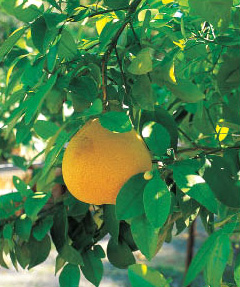
Grapefruit are good citrus choices for the Coachella Valley. This is 'Rio Red'.
Fertilizing Citrus
Make the first application of a complete citrus fertilizer in February to help set blossoms. Follow with one application per month until September. At the least, remember to fertilize on these holidays: Easter, Memorial Day, and Labor Day. Apply fertilizer according to product label directions. Dissolve in water or spread dry fertilizer evenly across the watering basin, and water thoroughly after applying.
Remove all dead wood, crossed limbs and control haphazard growth. Pull off suckers rather than pruning them to reduce the chance that they’ll regrow. Low-hanging branches around the perimeter of the tree should not be removed. They help the tree shade itself, preventing sunburn of the bark. If the tree is pruned so that the trunk is exposed, whitewash or wrap the trunk to protect it.
Lemons often require more pruning than other citrus due to their rapid and sometimes rampant growth. Heavy pruning may reduce the number of lemons produced, but it may improve the size and quality of fruit. Lemon trees may be pruned to fit the available garden space or kept at 8 to 12 feet high to make it easier to harvest the fruit.
Sun Protection
This is only necessary if trees are pruned too much. To avoid sunburned trunks, wrap with tree wraps or paint trunk with white latex paint diluted with water (50:50 solution).
Fruit Drop
Some immature fruit can be expected to drop after blossoms fall and until fruit becomes 1/2-inch in diameter. Excess fruit drop can be caused by lack of moisture or fertilizer, overfertilization, excessive pruning, sudden change in temperature, freezing, poor soil drainage and insect pests. Avoid these by careful irrigation, prune carefully, control pests and fertilize on schedule. (See Month-by-Month Gardening in the Coachella Valley.)
Frost Damage
Prune a frost-damaged tree only after new growth develops. Following a severe freeze, die-back may continue into late spring and summer. If the tree is heavily damaged, remove the fruit. Water only enough to meet the needs of the tree. Fertilize frost-damaged trees less heavily than healthy trees.
Harvesting Citrus Fruit
Fully ripe citrus will drop into your hand when the stem is twisted lightly. If you have to tug, the fruit is not yet ripe. If you must, remove fruit by cutting the stem.
Most citrus fruit can be left on the tree for long periods—some for several months. The rind must not be cut or split if the fruit is to be stored. Harvested fruit keeps best at 60°F, or at room temperature out of direct light. If stored in a frost-free refrigerator, plastic reduces withering. Frost-damaged fruit feels hard to the touch and the segments inside are often dry and mealy.
Pest and Disease Control
The average homeowner, even with several citrus trees, will not be much bothered by pests. Encourage insect-eating birds (see Creating a Wildlife Habitat, following) and you may never see a pest outbreak.
Monitor trees for severe infestations of aphids, thrips, scale and whiteflies. If seen in high numbers, you can treat with insecticides. If ripe fruit is on the tree, harvest enough for eating to last at least three weeks before applying any insecticide. A second application may be necessary three weeks later. Most important, use only products labeled for use on citrus, and follow all product label directions.
Gummosis is a bark disease, evidenced by scaly bark and sap flow, most often seen at the base of the tree. It develops after bark is sunburned, in poorly drained soils, or when wet soil remains in contact with the bark. Treat affected trunks by removing scaly bark and rinsing the area with one teaspoon of potassium permanganate diluted in one pint of water. Keep soil and moisture away from the wound.
Chlorosis can be seen when leaf veins remain a dark green and the rest of the leaf turns a pale yellow. It is a good indication the plant is not able to absorb the iron it needs. This can be treated by acidifying the soil beneath the tree with used coffee grounds, or 1 cup vinegar to 5 gallons water. Ideally, address the problem by adding organic mulch. You can also add compost to the soil, but dig up only one sixth of the root zone at a time. In sandy soils, iron may actually be lacking, in which case add iron chelate. A chlorotic condition also can be caused by excessive irrigation, which leaches away fertilizer and other nutrients.
_fmt.jpeg)
A dry creek bed can be used to reduce turf areas, provide an avenue for drainage and create a setting for a natural habitat.
Adding a Dry Creek to your Landscape
Many landscapes, large or small, benefit from the visual interest of a unique landscape feature—a dry creek bed. A dry creek bed identifies the landscape as truly southwest, simulating the arroyos of our local foothills.
This feature has the added benefit of reducing or eliminating lawn areas, provides a means for drainage and creates the backbone and setting of a natural habitat. Properly placed flowering accent plants, small shrubs, ground covers and wildflowers complement natural placement of pebbles, rocks and boulders.
Begin by creating a meandering swale 1-1/2 to 2 feet deep and 3 to 5 feet wide. Line the bottom and sides with 3- to 6-inch stones bolstered with clusters of 2- to 3-foot diameter boulders along edges. Bury rocks and boulders one-quarter to one-third of their depth for a more natural effect.
Natural areas such as this, with perennials and wildflowers, complement other plantings, and provide color for long periods. Native plants to enhance the feature could include ground covers such as Calylophus hartwegii, calylophus; Dalea greggii, trailing indigo bush; or Wedelia trilobata, yellow dot.
Add some color and varying height with flowers such as Penstemon species, penstemon; Baileya multiradiata, desert marigold; Hymenoxys acaulis, angelita daisy; Sphaeralcea ambigua, globe mallow; and Rudbeckia columnaris, Mexican hat.
Small shrubs such as Calliandra eriophylla, fairy duster; Cleome isomeris, bladderpod; Hyptis emoryi, desert lavender, and Ericameria laricifolia, turpentine bush; work well together, for both their foliage and seasonal flower color.
An added bonus is that many of these plants re-seed readily, reinforcing the natural appearance. The boulders and stones provide plenty of nooks and crannies to encourage seeds to germinate.
In a mature garden, a dry creek bed can help the landscape “flow together,” stimulating and creating a new, exciting look.
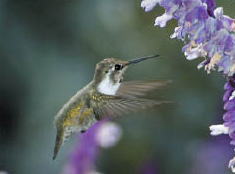
Plant flowering perennials to attract hummingbirds to your garden.
Every living thing needs water, food and shelter. If you provide these in your landscape, wildlife are sure to come. No matter how distant our urban areas are removed from nature, a surprising selection of creatures will discover your wildlife habitat. It is then that you will discover the magic and mysteries of nature so rich in our desert land. Your entire landscape can become a welcoming place for birds, butterflies and native animals. With proper selection of plants you can enjoy a lush, low-water oasis, wildlife and year-round color.
If you are unsure of how to begin, start small in a corner of your landscape, then expand as you begin to see what works and doesn’t work. Include as many plants as possible that are native to the desert. Locate habitat in a quiet part of the garden where trees and plants can grow as they will. Unpruned or lightly pruned forms will provide the food and shelter wildlife seek. Plants that grow naturally, with branches reaching to the ground, are preferred. Their density creates safe places for hiding, resting and nesting.
Water is a necessary element in a wildlife habitat. A water source can be as simple as a dripping faucet, a small, shallow fountain or a shallow water dish, such as a large decorative plant saucer.
Plants can provide food for wildlife without our even noticing it. Nectar, seeds, fruits, and larval food for butterflies are all important in the wildlife garden. Plants also nurture numerous different species of insects that are not pests, yet are important food sources for many species of birds. For example, hummingbirds require insect protein to lay eggs and raise their young. Also their tiny nests will fall apart without ample spider webbing in the construction.
Wildflowers and perennials with deep-throated, brightly colored flowers full of nectar are essential to attract hummingbirds and butterflies. Ground covers such as lantana and verbena are loved by butterflies. Flowers and grasses that produce seeds become dependable food sources for seed-eating birds such as quail, dove and lesser goldfinch.
A bird feeder or two may be fine to interest small birds, but avoid broadcasting great quantities of seed or grain on the ground. This often merely attracts larger birds and pigeons, which can stress the habitat and bird population. It may also attract undesirable rodents and the snakes that prey on them.
As the garden ages, the gradually enriching soil becomes an ideal home for earthworms, lizards and other soil-related animals and insects. They help develop a balanced food cycle for all the residents. And when you create the right environment, roadrunners, quail, thrashers, and other native birds help keep snails, slugs and other pests under control.
The list on this page provides just a sampling of arid land plants to help create your wildlife habitat. Also note plants as you read through Success with Desert Plants.
| Plants for Wildlife Habitats in the Coachella Valley | |
trees for shade and resting Acacia berlandieri, Guajillo Cercidium floridum, Blue Palo Verde Chilopsis linearis, Desert Willow Lysiloma watsonii var. thornberi, Feather Tree Olneya tesota, Desert Ironwood Prosopis velutina, Velvet Mesquite Vitex agnus-castus, Chaste Tree
shrubs for nectar, seed and shelter Anisacanthus species, Desert Honeysuckle Atriplex canescens, Fourwing Saltbush Buddleia marrubifolia, Woolly Butterfly Bush Cleome isomeris, Bladderpod Calliandra species, Fairy Duster Encelia farinosa, Brittle Bush Justicia species, Chuparosa and Shrimp Plant Punica granatum, Pomegranate
flowers for seed, nectar Aquilegia species, Columbine Baileya multiradiata, Desert Marigold Dalea species, Dalea (ground cover forms) Lantana species, Lantana (ground cover forms) Penstemon species, Penstemon, Bearded Tongue Salvia species, Sage Zauschneria californica, Hummingbird Trumpet Zinnia acerosa, Desert Zinnia |
vines for food and nectar Campsis radicans, Trumpet flower Passiflora species, Passionflower Rosa banksiae, Lady Banks Rose Tecomaria capensis, Cape Honeysuckle
cacti and succulents for nectar and seed Aloe species, Aloes Asclepias linaria, Threadleaf Milkweed Asclepias subulata, Desert Milkweed Carnegia gigantia, Saguaro Ferocactus species, Barrel Cactus Fouquieria splendens, Ocotillo Hesperaloe parviflora, Red Yucca Opuntia species, Prickly Pear
...and don't forget ornamental grasses |